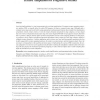Free Online Productivity Tools
i2Speak
i2Symbol
i2OCR
iTex2Img
iWeb2Print
iWeb2Shot
i2Type
iPdf2Split
iPdf2Merge
i2Bopomofo
i2Arabic
i2Style
i2Image
i2PDF
iLatex2Rtf
Sci2ools
CGF
2006
2006
Texture Adaptation for Progressive Meshes
Level-of-detail modeling is a vital representation for real-time applications. To support texture mapping progressive meshes (PM), we usually allow the whole PM sequence to share a common texture map. Although such a common texture map can be derived by using appropriate mesh parameterizations that consider the minimization of geometry stretch, texture stretch, or even the texture deviation introduced by edge collapses, we have found that even with a well parameterized texture map, the texture mapped PM still reveals apparent texture distortion due to geometry changes and the nature of linear interpolation used by texture mapping hardware. In this paper, we propose a novel, simple, and efficient approach that adapts texture content for each edge collapse, aiming to eliminate texture distortion. A texture adaptation and its inverse are local and incremental operations that can be fully supported by texture mapping hardware, the render-to-texture feature, and the fragment shader. Once t...
| Added | 11 Dec 2010 |
| Updated | 11 Dec 2010 |
| Type | Journal |
| Year | 2006 |
| Where | CGF |
| Authors | Chih-Chun Chen 0002, Jung-Hong Chuang |
Comments (0)

